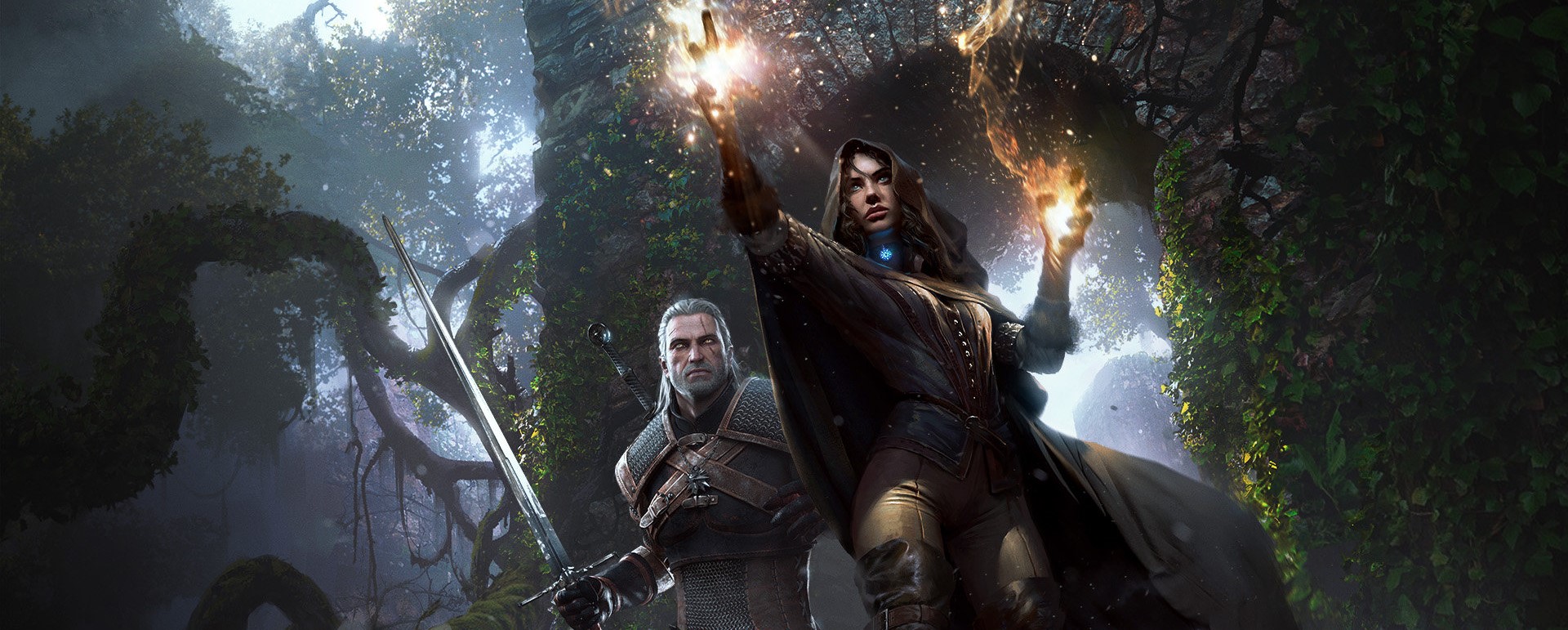Table of Contents Show
At long last, Kyle and Claudia return to The Witcher Retrospective. We do greatly apologise for our absence, life got in the way and time just slipped away. But we are more than happy to get back into this series and dive back into The Witcher Saga.
In this penultimate part of the retrospective, we analyse The Witcher 3: Wild Hunt on how it stands alone as a game and how it fits into the larger franchise. We figured The Witcher 3 is so big that it deserved us reviving the analysis portion one last time. This part along with the Q&A will be the last of The Witcher Retrospective published on The Daily Fandom. Due to the issues that led to us not getting another instalment in the retrospective in over a year, we have elected to end out the official part of the retrospective here. Fitting considering The Witcher 3 is the very thing that brought Kyle into the series. We will from time to time update the archive site with smaller instalments in the retrospective such as new seasons of Netflix’s The Witcher.
If you missed any of the previous parts, please go to the archive site we set up to preserve all of the parts that were lost to the void of the internet. There you will find the retrospectives on all 8 books, the first game, and the first season of the Netflix show.
Additionally, you can find The Witcher 2 retrospective here and here.
Combat Mechanics – Claudia’s Analysis
You know I spent a long time thinking about how to tackle this section. I’m a firm lover of games, but sadly have never been good at reaction time or reading the room (or monster, in this case). I’ve always struggled with real-time combat, and the Witcher hasn’t been an exception. I can’t say the Witcher 1 or 2 did much for me in that regard. The strange crafting and rhythm-based strikes were understandable if not my favorite.
Now without a doubt Witcher 3: Wild Hunt is leagues more polished than its predecessors. It feels like a AAA game and discussing Kyle’s read on the combat was enlightening. I think he covers the flaws in much greater detail than I could so I’ll leave the breakdown of those things to him. What I will touch on are a few things I did notice.
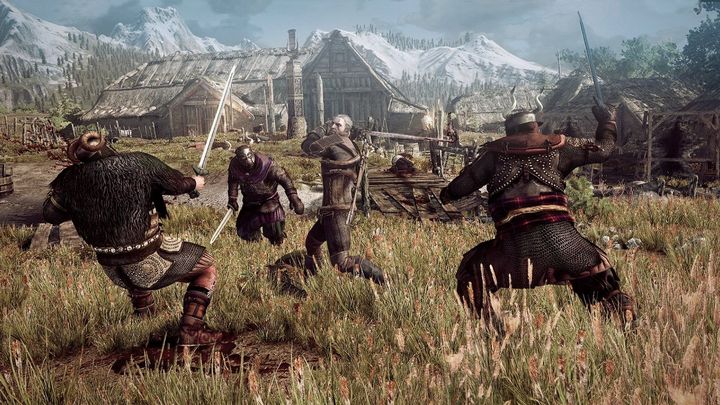
First I’m a firm believer that a lot of games try to do too much. Crafting and Exploration and Powers and Gwent and you know what I’m talking about. The Witcher games’ insistence on marrying the Alchemy system to their combat is fascinating to me and I wish I enjoyed that aspect of the game. As it is I find the crafting as clunky and boring as I do in most games. You wind up grinding to find ingredients and recipes and if you don’t end up dealing with much tougher fights. I wonder whether the team ever visited the idea of making alchemy work more like signs – consistent, refillable abilities that can be triggered until you run out of resources, and that can be filled up via harvesting. Granted doing this may not be a fun, good, or even thematic choice but it was a thought I had while bemoaning more crafting.
Another point I wanted to touch on, is just how much the Witcher 3 is pulling from Arkham. When the Witcher 3 originally released it basically skyrocketed, and much like Dark Souls and Fortnite, has left a permanent imprint on the gaming industry. Batman: Arkham Asylum was much the same. The combat feels and moves a lot like that game, with fewer counter indicators. It even has ‘Detective Mode’ in the form of the ‘Witcher Senses’ and while I have my own issues with that feature, it’s fascinating to me how much the Witcher stands on the shoulders of what came before.
All that to say that despite the fact I was spamming Ignii and fast attack all game, I enjoyed much of it and would dive into it more deeply on a second playthrough if I ever have that many years of my life to spare.
Combat Mechanics – Kyle’s Analysis
The Witcher 3’s combat system fixes many issues present in The Witcher 2’s while also creating several new ones in that attempt. Geralt now has two kinds of dodges instead of just one. He’s got the big roll, which is very situational but now he’s also got the more useful pirouette, which just fits better with how Geralt fights in the books. This increased manoeuvrability actually makes this gameplay better with a controller rather than mouse and keyboard in my opinion at least. The overpowered use of Aard has also been fixed, in The Witcher 1 and 2, it had the ability to stun enemies and thus give you an instant kill. In The Witcher 3, Aard is powered down, and only in later parts of the game with it fully upgraded is the Aard nearly as powerful as it was in previous games, but no instant kills though.
The biggest fault of the combat system comes with the fast and strong attack divide. These were present in The Witcher 2, but each served a purpose and could be utilised as such. In The Witcher 3, with both skill points and gear, you are encouraged to just pick one and not bother with the other. The damage difference between them in the early game is negligible, but the gulf between them becomes increasingly wide as the levels keep coming in. So, in most builds you are stuck with an underpowered attack and a very powerful one, if you are suckered into levelling both with skill points, it proves to be a waste of time and resources as you rarely if ever have to use one over the other.
Potions, bombs, and oils are closer to what they were in The Witcher 1 but still not as versatile as in that game. In The Witcher 2, the choice to make you take potions before the battle is lore-friendly but annoying and pointless from a gameplay perspective. So The Witcher 3 reverts back to allowing you to use them in combat ala The Witcher 1, but unlike that game, their reduced effectiveness and longevity is kept from The Witcher 2 and can only be remedied by spending points in the Alchemy tree. As such, I find it easier to just stick to two potions, Swallow and Tawny Owl, never bother with oils unless required for a quest, and the same with bombs. On the plus side, the potions now replenish when you rest.
The problem with signs in The Witcher 2 has been fixed to great success in my opinion. In that game, I found myself exclusively using one sign due to the limited skill system and not bothering with the others. In The Witcher 3, while you still find yourself choosing one sign and primarily sticking to it, there are times you have to change. Yrden is required to fight wraiths unless you want the fight to take forever and your sword to take tons of durability damage, and certain quests or zones require certain signs to be cast in order to progress. As such, you become familiar with the different signs and find them more useful than in other games.
User Interface – Claudia’s Analysis
I think this section was much more important to me in the older games, which were admittedly clunkier. But, to Witcher 3’s credit I hardly thought about the UI in the three years it took me to get through the game. That says a lot because I had to spend a lot of time with it.
Things were mapped reasonably well, and the PC port worked as intended, which is always great. As a PC player, I am forever rolling my eyes at bad PC ports and UI decisions. That said, I would love to spin this up on a console and see if the sheer volume of menus is as easy to navigate with a controller. I certainly had a few moments where I sat stumped, trying to remember where something was (hint: crafting and alchemy menus are very different) but given what they were trying to do, I think the menu bloat is largely understandable.
Once more Kyle elaborates beautifully. The Steel and Silver sword auto equip is *chef’s kiss* and the pathfinding is about as good as I expected for a game of this caliber. I also second the fact that the mouse wheel scroll menu was efficient and easy to use.
Unlike Kyle, though, I didn’t struggle so much with the interact button. I did, however, get stuck in doors. I got stuck in so, so, so, so many doors. I know it isn’t a UI thing but man I remember Witcher 2 doing this to me too. Please. Someone fix the doors. I beg. I don’t want to reload because Geralt can’t open a bathhouse door anymore.
User Interface – Kyle’s Analysis
The user interface in The Witcher 3 is thankfully a massive upgrade from the eyesore that was The Witcher 2. Things are well separated out, each section of your inventory having an easily accessible tab, and the physical items are presented à la The Witcher 1 rather than a list that you had to scroll through as in The Witcher 2. Most of the weight issues found in the previous two games are thankfully not here, while there is a weight system, it is much more generous to the player and thus leads to less inventory management.
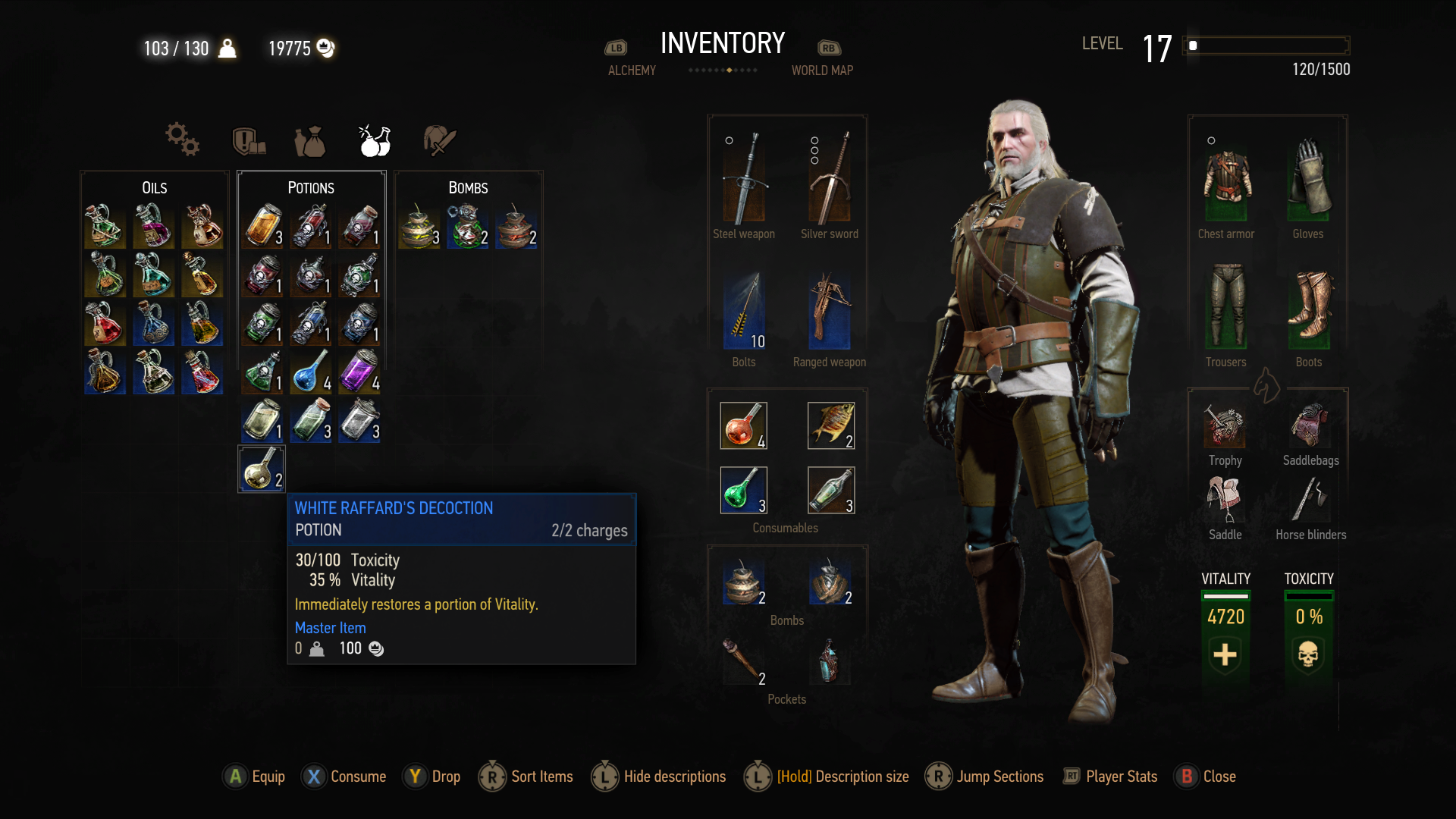
Several ease-of-use things were added such as crafting vendors having a button to purchase an ingredient while in the section to craft the item rather than having to go to the buy section. Switching between Geralt’s silver and steel sword is done automatically for the player, but the option is still there to do it manually. Accurate waypoints that take into account buildings and places with multiple floors unlike The Witcher 2. A quick item select for up to four items such as potions or food is for use in combat. Oh, and a far more efficient item select wheel that allows you to quickly switch between signs, use your crossbow, etc.
The main problem with the user interface primarily comes down to the way Geralt interacts with objects and people in the world being mapped to only one button. You often pick up the wrong item, interact with an object such as blowing out a torch or talk to the wrong NPC. It doesn’t help that these situations cause Geralt to go into an uninterruptible animation for a few seconds. It’s not anything major but it sure can get tiresome after a while. The other major problem comes in the skill system, as it doesn’t properly make apparent the need to “equip” a skill once it has been purchased. More issues with that system will be discussed by me in the Game Progression section. One minor problem is just how loaded down with Points of Interest the map is causing it to be very cluttered and annoying to navigate. This isn’t helped by the Points of Interest being the same few structures recycled, again and again, making them repetitive, boring, and completely superfluous.
Quest Design – Claudia’s Analysis
I’m going to keep some of my thoughts about the Narrative progression and writing for later sections and talk mainly about quest acquirement and chaining throughout the Witcher 3.
First things first, shout out to the camera system. Whenever Geralt interacts with a quest giver NPC (which will be often because this game is packed to the gills with quests) the player is treated to a little cinematic camera shot sequence. While these are clearly in-game, just pivoting the camera to capture faces and voice performance, does a ton for player engagement.
Quests are, typically, picked up through job boards (monster hunts), NPCs, or Story Progression. The job board ones are straightforward, and the game will delightfully let you close out a quest in the dialogue if you happen to have already killed the corresponding monsters. This is a quality of life feature I adore in RPGs. Makes you feel extra badass to walk up to an NPC and say “already taken care of.”
The other NPC quests are variously involved and actually have some brilliant little writing moments which I’ll speak to more in the Narrative Section. These ones suffer a bit more for being done out of order but are probably my favorite subtype. Even within this, though, the complexity varies, from helping Keira gain access to the Tower of Mice to tracking down missing goods. A note here is that Kyle wouldn’t consider Tower of Mice a side quest, but I do. I think this has more to do with categorization and game standards.
While Kiera is tied to some of the main plot events, she’s firmly not as important as Yen or Triss and stands as more of a side character. This particular quest is listed as “secondary” which maybe is a better way to classify the storytelling calibur of the various questlines. The secondary quests in this game are spectacular, and many tie into the Primary quest progression. Those that don’t still offer interesting choices and demonstrate the moral bleakness of the world (such as Funeral Pyres and Kyle’s favorite Black Pearl). This is wholly intentional and is why, I would think, Kyle does not consider them side quests. However they very much are, and The Witcher 3 is good because they are as well developed as they are. The treasure hunts and contracts stand firmly in their own category, and while they serve to offer loot grind and bloating it’s definitely something I judge differently.
Finally, the main questline is interesting and probably where most of my problems lie despite the excellent payoff. Many main quests break out into dozens of smaller objectives which will sometimes spawn as their own quests. These, even more so than the secondary quests, tend to be sped across the map, which is a huge pain if you didn’t painstakingly explore every corner early on to get your fast travel markers. Moreover, the journal becomes a little tricky to follow when the details needed to complete your main quest is buried in another quest further down the list.
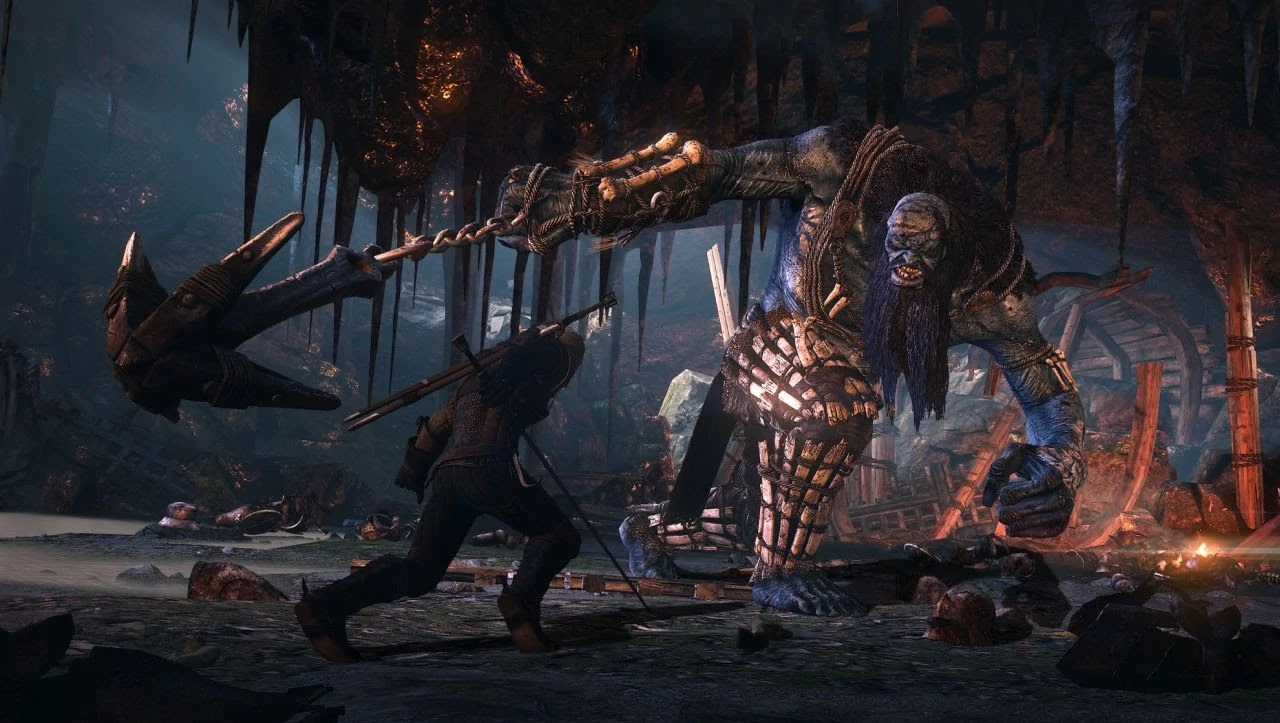
This is then coupled with a decision to make many late-game mission chains. These are of a “complete all the personal quests of your friends to secure their help” variety and while the big one happens at about the two-thirds mark, I found the lead up to the actual end to have similar running around. I despise quests plotted across the map for no reason but to make the player travel, and while I adore the Bioware Loyalty Mission structure Witcher stumbled here for me.
The Loyalty Mission structure worked because the missions naturally unlocked as you spoke to companions, were tightly timed into the fabric of the main quest, and came up in such a manner that they didn’t require massive backtracking right before a huge moment unless you had been going out of your way to neglect them. In The Witcher, these quests don’t have any of that going for them, and some backtracking is going to be unavoidable. This is probably my primary issue with how the main throughline was handled and if I could fix anything, I would make these quests feature more prominently earlier.
Also, we could do without some of the fetch quests probably.
Quest Design – Kyle’s Analysis
The quests in The Witcher 3 are the thing that most people praise about the game with their acknowledgment of choice, interesting stories, and overall design. But, in my opinion, this praise is too easily heaped onto The Witcher 3 when in all honesty, it isn’t all that different from your average RPG in terms of quest design. Some quests are given a great amount of care and attention, wrapping you up in their plots and characters, making the gameplay fun and inviting, and as such makes a really good impression on the player. But this is only a portion of the quests, others are clearly your standard fetch quests spruced up to trick you into thinking otherwise or have so little story or anything of note to them, that they quickly become forgettable.
“The Lord of Undvik” was the first quest designed for the game and boy does it show. It suffers from the same problem many quests from Divinity: Original Sin 2 do, which is too many variables. There are multiple paths throughout this one quest and it’s easy to mix and match the paths, get turned around, confused, and just plain get lost. In the final part of the quest, the variables decrease significantly, and it becomes more manageable. This isn’t to say it’s a bad or not an enjoyable quest, it’s just that this “Any way you want to go” approach to quest design leads to many people who rely on clear and concise instructions in their quests, to be very confused. They clearly learned their lesson with this quest, as few other quests in other zones have this very strange design, though some have a smaller scale version of it.
I’m glad the quest journal sections out quests based on their type as that easily tells me what to skip. The monster hunts rarely have compelling stories, and the rare times they do, don’t make the journey to get it done worth it. Treasure hunts are useless except for Witcher Gear, which I’ll talk about more in Game Progression. It should say something that despite how much people say that the side quests in this game are amazing, that the quests they always remember are tied to the main story in some capacity. They are either branch quests from the main story such as the Bloody Baron stuff, or they involve a major character from the main story such as “A Towerful of Mice” or “Carnal Sins”. In my opinion, they severely overcompensated for the lack of a lot of side quests in The Witcher 2 by filling The Witcher 3 to the brim with them. This is a severe quantity over quality situation here.
It should also be noted that in order to get certain results from quests, the only option is to just not do the quest. For instance, getting Radovid to win the war requires you to not complete “Reasons of State”, due to Philippa killing him in the course of that quest. This is really dumb design, as most players, especially ones like me, will never turn down a quest due to the XP reward. For a game praised for taking into account player choice, it sure doesn’t communicate its various paths well if just not doing the quest is a viable option, and doing it pigeonholes you into a narrow path.
Game Progression – Claudia’s Analysis
This game actually delightfully avoids a problem I’ve encountered in many a game when I play AAA on the console and that is: meaningless choice in power progression. Granted there are other things that render some choices meaningless, but at the very least on your first playthrough, you’ll need to pick and choose which things you’re leveling up carefully as you will not get access to everything. However, the game is large, and to Kyle’s point you will have a surplus but, well, at least for me I learned some valuable lessons in not dumping points into Aard.
However, as I said, this can be rendered moot by the fact the way the game is built makes strong attack obsolete, and the inability to dump more points into signs really does mean you’re sticking to your go-to outside of unique monster use cases.
I also agree with Kyle’s assessment that the loot grind, one of the premier RPG progression staples, really falls flat with crafting making quest items obsolete. He explains it better so go look there.
I’ll say, though it’s not revolutionary, it’s worth making a small nod to the level locked areas and the way the game telegraphs your growing strength through the more challenging areas you can suddenly move through. I adore challenge ratings not changing to match you, if you ignore the skull on the health bar and go to your death that’s on you, and it’s something that makes some of the returns to early game areas bearable.
Game Progression – Kyle’s Analysis
The Witcher 3’s game progression is probably a tad better than the previous two games but still incredibly flawed. The biggest red flag is the levelling system and by that, I mean skill points. When you buy a skill with a point, it is not automatically applied to Geralt. You must “equip” said skill on one of four rows that can hold three skills each. This means you are limited to twelve skills in total, augmented by equipped mutagens. Considering there is no level cap in the game, over levelling is a common occurrence, and the final portion of the game hands out levels like they are candy, you are going to have a surplus of points. You can spend them on dump skills if you want, but once you have all twelve slots filled and you enjoy your build, there is no reason at all to do that. Levelling stops becoming a reward and just becomes a thing that happens that you ignore.
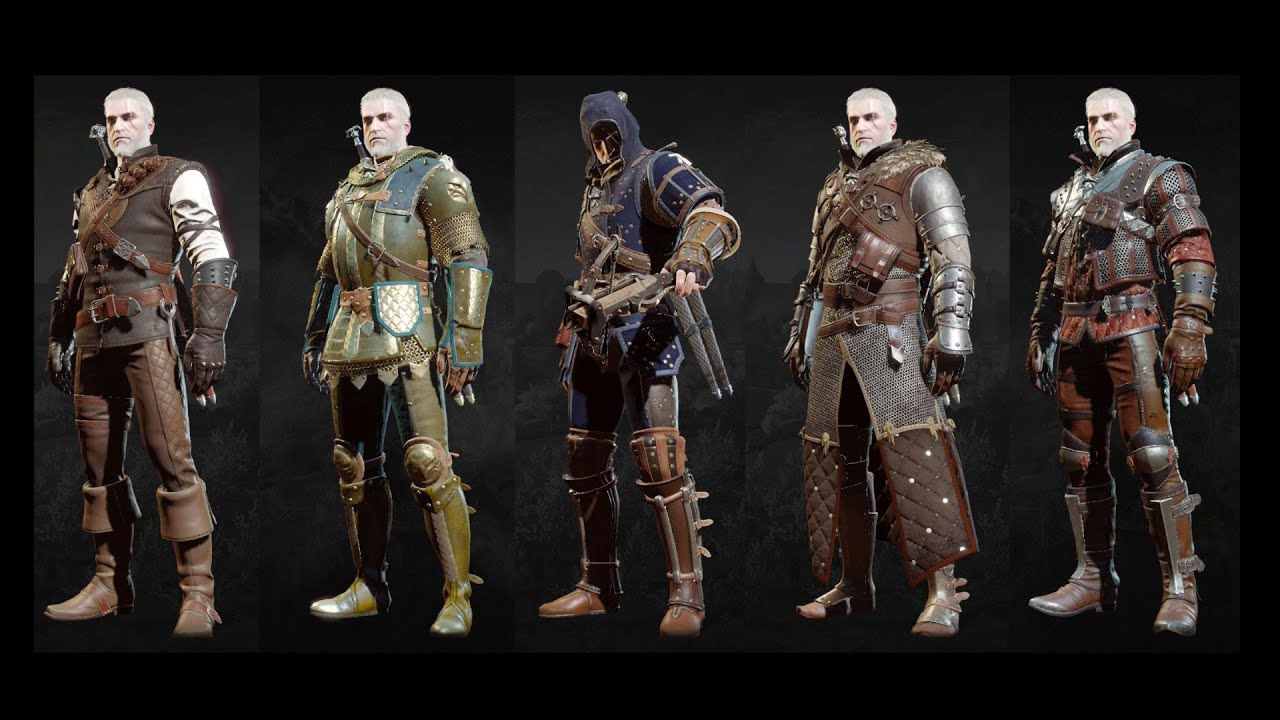
Another major problem with the game progression is the gear system. Once you are able to build your first set of Witcher Gear, there is no reason to ever look back. No dropped item, randomly looted item, other crafted item, or quest reward is going to be better than that set of Witcher Gear. It runs into the same problem that The Witcher 1 did with its gear system, granted a little better handled here than there. Add the insult to injury that is special items from quests being always under your level by design, and you get a gear system that is just broken and pointless. Crach an Craite can give you a sword that has been in his family for generations and the first thing you will do is sell it. The only benefit this system has is that it gives Geralt a consistent look, with the Witcher Gear slowly becoming more developed with each stage. There is nothing I hate more in a dialogue scene than to have the main character wearing miss-matched clothes.
Despite these problems, the feeling of the game as it progresses is rewarding. You gain more confidence in the gameplay, Geralt grows stronger and more confident with you, and the power level of your signs noticeably increases. I have never been big on crafting mechanics, but I do appreciate that there are advanced versions of the standard potions such as Superior Swallow, and I like how you can get these during the Battle of Kaer Morhen if you didn’t focus on Alchemy.
Narrative Design – Claudia’s Analysis
This is the place where the game shines. I’ve addressed the backtracking and my thoughts on how to fix it earlier so let’s talk about all the other narrative choices made throughout the game.
First of all, the Deuteragonist. Now I don’t know if it’s my love of Ciri bleeding through here, but I adored the choice to use the Ciri segments as part of the main storytelling. First of all, gameplay is almost always a better choice than an extended cinematic. Ciri also felt mechanically distinct from Geralt, with a unique teleport ability that let you delightfully zoom around. While the inclusion of the segments felt a tad shoehorned, it also helped keep Ciri relevant even as you may have been slogging through hours and hours of content in between main quests.
And there’s something to be said for the way a player connects to a character they’ve played. While nowhere near the level of, say, killing off your Hawke in Dragon Age: Inquisition, it still does the job of endearing, at least me, to the character (and also leaves me quietly wondering why this wasn’t just a game about Ciri instead).
The main quest structure outside of the backtracking was also marvelous. Quests definitely have a wide variety of detail and impact. For smaller quests we see our results pretty quickly (Wild at Heart a brilliant little quest about a werewolf and his poor missing wife plays out rather immediately after you discover the truth about her disappearance and take a side) some of them have much farther-reaching consequences. As the game reaches its final third, this is when these consequences not only begin to roll in, but you start getting hit with more meaningful quests and pursuits to try and shape the outcome you are careening towards. It’s hard to describe without playing it but starting from the defense of Kaer Morhen from the Wild Hunt onwards the game hits a gas pedal and doesn’t let up.
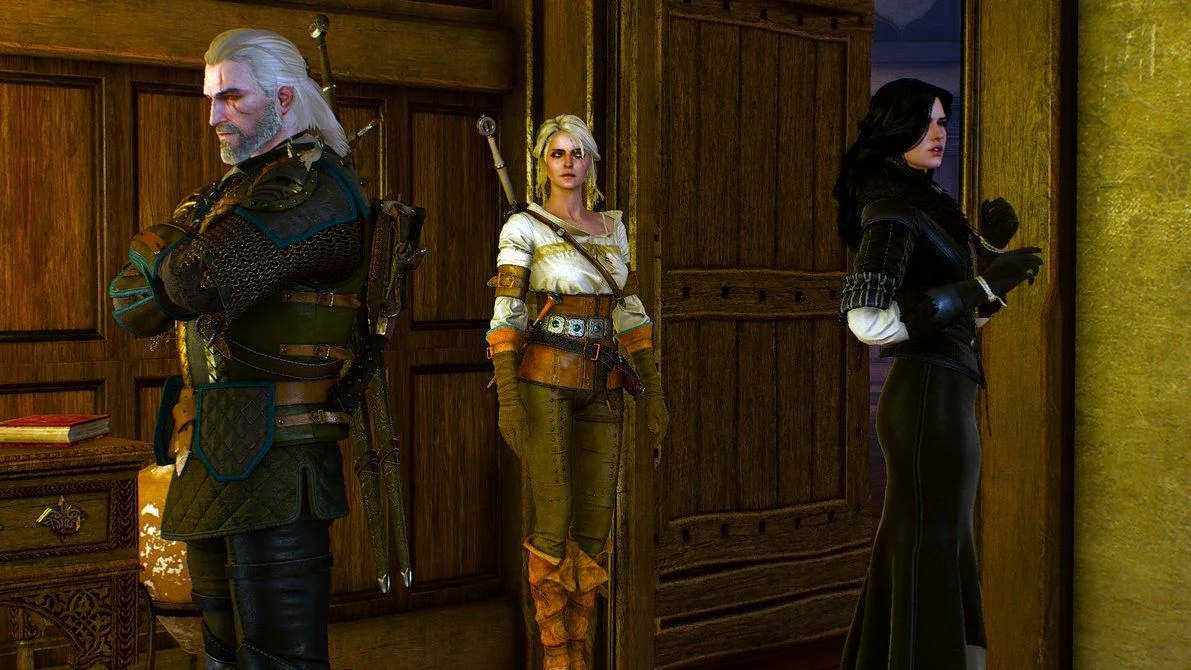
If you liked the meandering sidequests this can be rough. If like me, you were trying to see what this Game of the Year stuff was about, it’s amazing. This was the part where I ignored Djikstra’s invitation to solve some political issues because I was too focused on Ciri and not liking him and found myself staring down one of the worst political endings of the game.
Finally the most important part of the narrative decision-making in this game, in my humble opinion, was the choice of how to convey, control, and execute the final resolution of Ciri’s storyline.
The game set the precedent with every other quest that Ciri’s fate should be impacted by your choices, and they do follow through with this. Much like other quests, your choice of dialogue has no marker or little ‘Ciri Liked That’ to indicate if you are on the right path or not. And there’s no indication of the importance of various conversations. Is this moment one that will seal her fate? The game leaves it somewhat ambiguous until the final moments.
Unlike most other quests the conversations sealing Ciri’s fate aren’t locked to a single quest or an obvious to see decision. The team really did decide to let players blindly stumble through their interactions with her. Much like Geralt must blindly stumble through being a father to this girl he never asked for but also looked out for. Honestly, it’s nearly poetic and as sappy as some moments become, truly the best part of the game for me.
The final scene where Ciri faces down the White Frost ends with her flashing back to these interactions, which will then clue the player in, too late to change it, to how important Geralt’s actions and words were. In those moments the players watch Ciri literally reflect on the decisions they made…and then walk into the unknown.
You don’t find out until much later if she survived.
Outside of my heart-wrenching first playthrough of Dragon Age: Origins this may be the best capstone ending to a game I’ve ever seen.
Narrative Design – Kyle’s Analysis
The narrative design of The Witcher 3 is all over the place. It can be broken down into the prologue, Velen, Novigrad, Skellige, mid-game crisis, backtracking ending, and epilogue. This was CDPR’s first attempt at an open-world game and the meandering nature of the main quest and zones reflects this. Sadly, in a post-Cyberpunk 2077 world, they never got better at open worlds. Don’t get me wrong, the story has some good emotional moments, well-developed subplots, and interesting inversions of gaming tropes, but that doesn’t mean it gets a free pass.
The prologue is a decent introduction to the gameplay systems, world, and characters. Geralt being this focused on finding Yen after restoring his memories in The Witcher 2 is refreshing, because at last, the series isn’t trying to avoid her existence anymore. The Velen subplot involving the troubled and abusive family life of the Bloody Baron is incredibly well done. This is very much in the vein of Sapkowski’s style, using this world and characters to touch upon very difficult subjects and presenting a nuanced look at them. Speaking of Sapkowski, the device of having characters recount their encounters with Ciri and having the player play it through her eyes is a great way to emulate his style.
Novigrad is probably the part of the story I’m the least engaged with, not for the obvious reason that being Triss, but just that overall, it feels off. Seeing Dijkstra and Dandelion is nice but getting involved with the criminal element and dealing with the Witch Hunters just doesn’t strike the same thematic core that Velen did. Skellige has Yen, need I say more? Alright, favourite characters involved doesn’t mean a good narrative, I know, but boy does it help. You get to Skellige in a very odd manner, the pirate attack coming out of nowhere, but besides that, this is a strong zone. All the characters involved are either book characters, or original characters you grow to like quickly. The biggest problem is just all the travelling between the islands.
The mid-game crisis is exciting because you finally get to find Ciri. The reunion is brilliantly done, and I love the flashback to them finding each other in Something More. I wished these games gave us more book flashbacks like that. I appreciate how CDPR regularly tricks you into thinking this is the end of the game. The constant reassurances that you can’t turn back at the Isle of Mist and the Battle of Kaer Morhen being of the quality and scale of most RPG’s ending sequences such as Mass Effect 2’s Suicide Mission. The ending involves a lot of backtracking and is in my opinion a bit long in the tooth and was going to be longer according to interviews. I will get more into its issues when related to characters in the Adaptation section. It’s a decent build-up, with a lot of choices coming back, and the focus changes from finding Ciri, to caring for her and letting her determine her own path, much like the end of The Lady of the Lake.
There are three possible epilogues. The decision to keep the mystery of whether Ciri survived or not is well done, having you complete a small quest before finding out. There are enough red herrings to point to any possibility. Of course, there is only one in which she dies, and it is rightfully heart-breaking. The Empress ending has some sweet moments but makes no sense if you have read the books and is out of character for Ciri. The Witcher ending is the best of the bunch and is the most reminiscent of the ending of the books, even if Geralt and Yen are alive.
Graphics and Sound – Claudia’s Analysis
I feel like there isn’t much to say here. I’ve already given my regards to those who worked on the conversation cameras. For their time the graphics were amazing, and I’m at a disadvantage playing it so many years later.
Still, there are some things that remain stunning. Yennefer and Ciri’s designs come to mind, despite the poor costuming choice for Ciri. The combat animations on Ciri are delightful and help set her apart. The music, I think it goes without saying, is iconic and still features prominently in my D&D games.
The designs of many major characters and villains, such as the Baron, the Crones, Uma are all creative and distinct.
But I think what I appreciate most is that before the Witcher I’d never really, truly, experience an open-world game. The awe of walking around a world, a world that felt somewhat real and solid at first glance, is difficult to replicate. I recall my first play session wandering around the fields and trees and simply thinking, “I understand, now, why this won game of the year.”
You become used to it a little too quickly, and the repetitive winding paths get tiring. But to the credit of the team each region feels distinct, has its own reusable assets to love, and any game that can make me go “woah” in the first five minutes gets my five-star review.
Graphics and Sound – Kyle’s Analysis
I think this can’t go without saying, but The Witcher 3 is a beautiful-looking game. The jump in graphical fidelity from The Witcher 1 to The Witcher 2 was impressive, and now The Witcher 3 comes along to knock them both out of the park. Now, the game is six years old as of the time of this writing, and it’s starting to show its age. Many modern games blow it out of the water of course. Frequent clipping and constant reuse of the same character models that they don’t even bother to hide in the frame, bring it down somewhat. But the sheer attention to detail in every single environment from houses to cities, to forests, is amazing.
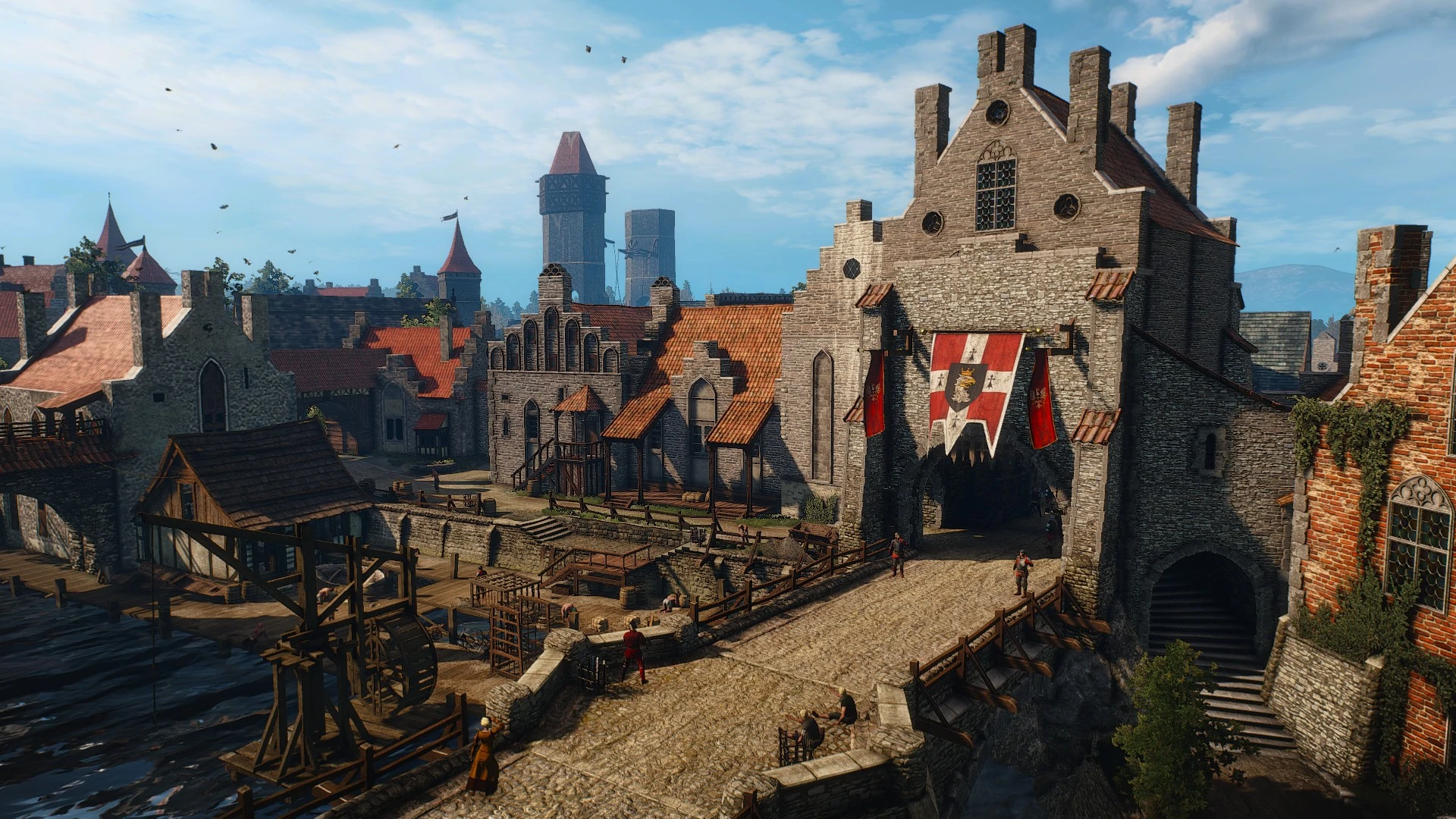
The colour-grading present in The Witcher 2, is still there but toned down a whole lot, so extreme bright colours are only there when it helps convey an emotion instead of all the time. The Witcher 1 has such a sense of atmosphere that perfectly captures the tone of the books, that each game after it has had a tough time measuring up. The Witcher 3 manages to capture that atmosphere and tone for the most part, with only a few hiccups here and there, and really transports me into this world.
The soundtrack is really good, probably the second-best in the entire series. The Witcher 1 hedges it out as its soundtrack is simply one of the best game soundtracks I have ever heard. The Witcher 3 brings in the band Percival, who are named after Mr. Schuttenbach himself, to add to the overall sound. They are a rock band with folk influence. The problem I had with Witcher 2’s soundtrack was that it tried too hard to be rock and roll, a bit too modern. The Witcher 3 manages to strike a balance, using modern instruments and arrangements but doing it in a way that complements the atmosphere of the world.
The biggest problem with the visual presentation of The Witcher 3 comes down to when it tries too hard to be cinematic. There are many times, especially in the Battle of Kaer Morhen, where they have characters do fantastic feats of strength and be very mobile. The models are a little too stiff for this, and as such some of these moments can come off as looking clunky, completely missing the intended tone, such as the death of Vesemir. Additionally, many times these cinematic scenes, despite being rendered in real-time and not being pre-rendered, don’t take into account alternate outfits for certain characters. Also, the dynamic beard growth was clearly implemented for the sole purpose of demonstrating the technology involved, especially considering Geralt is quite vocal about hating beards.
Adaptation – Claudia’s Analysis
The first problem with the game as an adaptation is that, in retrospect, this is a terrible section. The game isn’t an adaptation. By this part of the series, it is firmly a different world for a number of reasons.
While I adored the technical quality and writing right out the gate with the Witcher 3, the first glaring issue becomes apparent very early on: Emhyr is not married to fake Ciri, is open about Ciri being his daughter, and wishes to find her. This is counter to everything in the books and frankly puzzling in many ways because it feels like they could have left Emhyr out and simply had the find Ciri quest originate from Yen and Geralt themselves.
Then again, countless a player has ignored their son in Fallout 4 so maybe this change was good for player engagement but it wrecks a lot of the magic of the books for me. I love the ending of the original novels and would have loved to see that played out instead.
Moving past that, Triss’ role is a curious one as well. As I recall she fell into bed with Philippa by the end of the books and the game, all three of them really, have in the place of Book Triss built up a wholly new character in her stead. This character is almost good, with a major problem that results from the clumsy adaptation – in order to have their Triss and reintroduce Yennefer, Geralt has to be written as having slept with Triss not knowing of his previous level of commitment to Yen. What ends up happening is Triss, who is otherwise heroic, clever, and powerful, comes off as creepy and manipulative, having gotten Geralt into bed while amnesiac. And this is never called out and is largely treated as Geralt’s fault by the narrative, outside a small apology from Triss.
This rather problematic storyline could have been entirely left out if they hadn’t been grappling with adapting these characters with set plots into a choice-driven game.
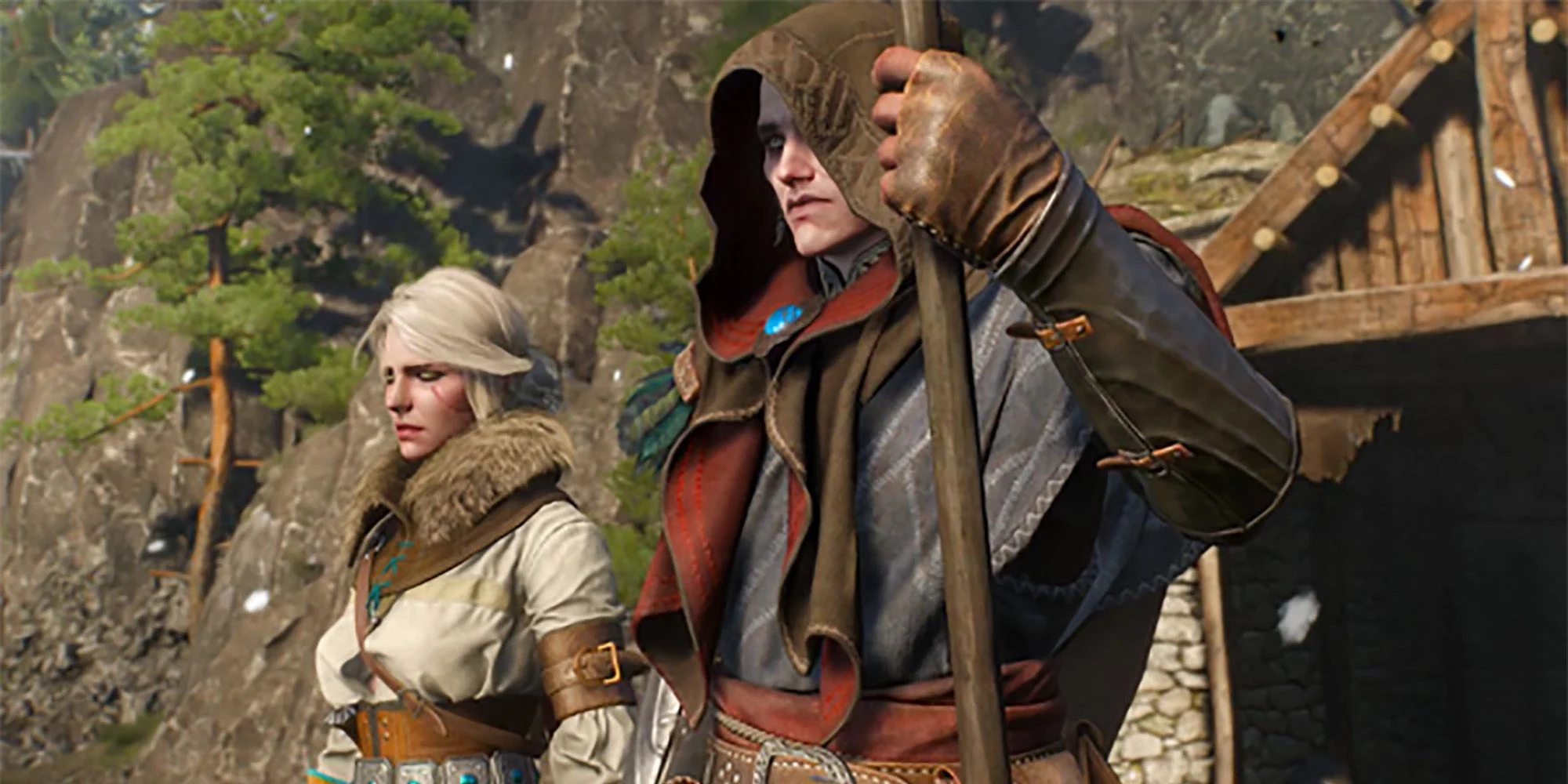
Finally while I agree wholeheartedly with making Ciri a chosen one (the woman wanted for who her child will be storyline is overwritten and sexist in many ways), I find the White Frost a bit of a letdown. The idea of natural climate change and the mundane destruction of worlds being the cause of the omens and past mass migrations tickled me and gave Sapowski’s world a unique flavor for a fantasy that is otherwise very pulp action-y and generic.
Otherwise, the game captures much of the books beautifully. Yen’s sass, Ciri and Geralt’s bond, the personalities and exploits of Dandelion and Dudu, and even introduces characters like the Baron who seem as if they were written by Sapowski himself. Tonally it’s exactly what I would expect and frankly probably adapts the feel of the books better than the other two games with its larger-than-life narrative and graphics.
Adaptation – Kyle’s Analysis
I used to be incredibly hard on this game after I had read the books, though after the Netflix show, I’m a little lighter on it because that show butchered some of my favourite scenes. As I have mentioned before in this retrospective, I played the prologue and part of Chapter 1 of The Witcher 1 at the insistence of a friend, it didn’t connect with me, so I quit. Years later, after going through some troubling stuff, the same friend recommended to me The Witcher 3, I tried it and fell in love very quickly. I had ordered the books by the end of the week and devoured them after I had completed The Witcher 3. I was confronted with the fact that while this game shares a lot of characters in common with the books, they have been changed in many ways. Some of these changes were present in the previous games, but the changes to Yen and Ciri, the sacred characters of this series, were only present here.
Yen isn’t too far off, but there have been some changes to her feelings and relationships with other characters that really affect the way she is presented. The most egregious for me is her now apparent distance with Ciri. Besides the one scene in which she runs to hug her, most of the intimate scenes with Ciri are only with Geralt. The game presents it as though Ciri is closest with Geralt and Yen is just a hanger-on, which considering Ciri wanted to be called Ciri of Vengerberg after her mother, that couldn’t be further from the truth. Additionally, many characters such as Vesemir and Dandelion now speak of Yennefer as if she is a horrible person, and her reckless actions which are perfectly in character, are judged as being bad. This has led to many players calling her a “bitch” and not liking her. Finally, “The Last Wish” quest undoes the beauty of the ending of the short story of the same name, by making Yen doubt her and Geralt’s love. This is so dumb; the TV show made the same stupid mistake. But this bit stings harder because this quest is only here to give players the opportunity to retcon 8 books of true love so they can get with CDPR’s precious redhead, Triss. My one and only response is: “Fuck off game!”
The changes to Ciri are the worst by far. Fake Ciri apparently doesn’t exist and it’s common knowledge in Nilfgaard that Ciri is Emhyr’s child. This causes so many plot contrivances and problems that The Witcher 3 can’t even be considered in the same universe as the books. Emhyr wants to abdicate to Ciri, why exactly? Additionally, information that is actively known by Ciri is treated as a reveal in the final bit of the game. For some reason she befriends Avallac’h, you know the guy who helped engineer her bloodline, was obsessed with her ancestor, and was effectively a eugenics obsessed Nazi. This is headache-inducing in its own right, only exacerbated by the fact that they fake a betrayal by Avallac’h, just to turn around and say he likes Ciri and means well. When his obsession with the Elder Blood is revealed, there is a scene where Ciri rages and, based on player choice, can wreak Avallac’h’s office. But Ciri already knew this information! Did The Lady of the Lake just not happen?!?!
Then of course there is the problem of her returning to this world in the first place, but much like Geralt and Yen’s resurrections, it’s dumb but an understandable move to make the story work. They also elect to reinterpret Ithlinne’s Prophecy in order to make Ciri the Chosen One, you know the thing she was designed to deconstruct. I know Claudia will make mention that people wanting her for her womb is sexist and whatnot. But that is literally the entire point, how these prophecies, expectations, and the fact of her gender literally erases all her agency, that she has to fight for free will. That’s the allegory, that’s the theme, that’s what this entire series is built upon: the right to choose. To make her the chosen one undermines all of that, saying effectively that she had no choice, flying in the face of one of the core themes of the Saga. The most heart-breaking change is the aforementioned dynamic change between Ciri and Yen. At one point Ciri will tell Geralt “Yennefer has plans for me, but Avallac’h is different.” This one sentence implies a malicious mistrust between mother and daughter that just isn’t there in the books and is really dumb. Every time I replay The Witcher 3 and get to that line, I actually scream in rage and have to pause the game for a bit to calm down.
The Witcher 3 is a mixed bag on many levels, but none more so than the adaptation level. As despite everything I said above, they do a good job capturing the tone and atmosphere of the books. And at times they really hone in on Sapkowski’s unique storytelling style and manage to adapt it to gameplay, which is brilliant. There are also moments in this game that are genuinely emotionally affecting or thematically deep. This game is not lacking in the storytelling department by any means, it’s just that these aren’t exactly the characters I fell in love with from Andrzej Sapkowski’s beautiful prose.
Conclusion Of The Retrospective On The Witcher 3: Wild Hunt
Thank you for joining Kyle and Claudia on this penultimate part of The Witcher Retrospective. The Witcher 3: Wild Hunt is many people’s touchstone for the franchise at large, so hopefully you found their analysis interesting. The final part will be as usual, a Q&A between Kyle and Claudia discussing The Witcher 3 in more depth.
